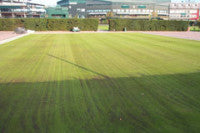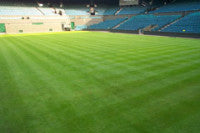Film Crews and Tournament success
Film Crews and another Tournament success

The weather has been good for us all this year, certainly in preparation for the tournament. The first week of Wimbledon was dry and although the second week was a bit wet, it didn't pose a major problem for us. Our biggest bonus for the tournament was that the daily temperatures didn't become too hot. One of the problems associated with excess heat is that it becomes difficult to get enough water on to the courts, knowing that they will be played on the next day. If it gets too hot, then they get harder, wear quicker and eventually start to crack.
After last year's tournament in 2002, when the grass did wear a bit more than we would have hoped and the courts were a little harder, we took a conscious decision this year to start the tournament with the courts being a little softer. We still had the ball bounce that we required, but we managed to retain a little bit more moisture in the base of the courts. We felt that the courts kept a much better colour and also the wear was considerably less than the previous year. I shall be elaborating on this at the NTF Conference at Southport in November.
From our point of view the tournament was very successful, we didn't get a single complaint from any player this year about any court. The reports that we receive after the Championship from the various governing bodies were also very positive.
My staff have again been tremendous this year, we recruit temporary staff each year and this year we've had people from Canada, Australia and Chile, all of whom have gelled and worked well with our permanent team.
The big work this year came after the Championship, where we had the pleasure of welcoming a feature film crew into Wimbledon for a six-week shoot. A lot of the outside courts and Centre Court became a film set. We had just three weeks to get Centre court and the other courts back to how they looked before the tournament ready for the filming.
We managed to get all the courts back to pristine condition, but initially it was worrying as entertaining a film crew was an unknown quantity that we had never experienced before. To walk out onto Centre Court and see about 90 people and riggers, as well as cranes, scaffolding, tracks and boards was a little bit concerning. Everything seemed to go well, and just recently they came back for a few more shots around the complex, I met the Producer again who told me that they had been pleased with the outcome of the filming.
While all this was going on, we were also maintaining our other courts for the members. We have been so thankful for the dry weather, because our renovations on some of the more important courts obviously started that much later. I was concerned that with 41 grass courts, we may have been caught out if the weather had turned. In other years we may not have been able to complete all of the renovations before the onset of winter.
Fortunately the weather has been extremely kind in this respect, and the courts have all been renovated now, the new seed is up and we have even had the opportunity to apply a second dressing on to some of the courts.
We are now prepared and ready for next year, and in fact our preparations for the next tournament are under way with other aspects of our duties here at Wimbledon. All the staff recruitment has been finalised for next spring, and I have management meetings in place.
The winter months are getting shorter for us in terms of downtime, because of other projects that we are undertaking. We're about to relay our croquet lawn in-house. This will involve stripping off the top 50mm of turf and rootzone, importing some new root zone and ameliorating it into the existing soils. Then new turf will be re-laid on the top.
In terms of on-going maintenance, the grass courts will be dew brushed every day and checked for disease, we will mow them as required as we maintain them at a height of 14mm, so once they grow to 16mm we cut them when weather conditions allow.
Aeration will continue probably up until Christmas with solid tining operations. This will then stop, simply because of our preparation for the next tournament. If we continued tining through the winter into early spring, then we would run the risk of the holes opening back up again during the tournament when the courts start to dry out. This isn't necessarily good turf practice, but nonetheless is the best method for us in our circumstances.
We've been quite lucky with disease, in as much as we haven't had to deal with many outbreaks this year. We do, however, check the courts daily and treat as necessary.
I only use two preventative sprays during the year. The first one is before the tournament starts, as we have covers going on and off the courts, which creates humidity and encourages disease-something we can ill afford just prior to the tournament. The other time is at Christmas. Due to staff holidays we use a preventative fungicide that allows us to at least enjoy a few days at home with some piece of mind!
Questions are asked as to why we haven't encountered so much disease, and I don't think that it has much to do with the weather. The last three years have seen the grass sward changed to a 100% perennial Rye mix. We have also significantly reduced the amount of Poa in the courts. The sward isn't nearly as tight as more traditional mixes, which therefore allows better air movement between the blades of the grass. By removing the Poa, we haven't a dense base of grass that can readily harbour disease either. Last winter we sprayed twice and this summer has only seen one application of chemical. Prior to changing the grass mix, we would have 
With regards the perennial rye grasses, I'd never consider going back to the use of other species. We have on-going trials with the STRI on new Rye cultivars; some of them are on the market now and some that will be out in the market in the next few years. The new cultivars continue to improve in terms of their play and wear characteristics. Although they produce a good sward, it isn't as dense and we've also found that using ryes has meant that we carry out far less rolling to get a hard surface.
We used to spend hours and hours rolling, and now we have reduced the time by about a third. Primarily this is because better air movement to the surface of the court enables it to dry out quicker. This helps us to get the ball bounce required, without having to continually roll the courts. This is labour saving, but it also means that we do not have to over consolidate to achieve what we want. It also means that we can get the courts bouncing perfectly on day one of the tournament. In years gone by, we wouldn't achieve this type of hardness, until about day ten.
The characteristics of the court now allow a longer rally game as pointed out to me by the press. This means that there is less serve and volley type matches played, which some would say is detrimental to the game. The reality is that most tennis is now played from the base line, and there are very few serve and volley players. Most of the top class tennis players play on hard surfaces throughout the year, so to emulate hard court characteristics on natural grass courts is an advantage. Now that we have bounce from day one, players can stay at the base line and play their natural game from the start of the tournament.
The grass courts will come back into play mid May next year.
There are ten hard courts to maintain that members like and continue to use in the winter. The hard courts require brushing and marking as well as weed killing. Three of these courts have frost covers that require moving on and off depending on the weather forecast.
We have over 300 6' wooden benches that spectator's use during the summer months, so amongst our winter jobs all of these benches need to be power washed, rubbed down and re-varnished.
There is always something to do, even in the depths of winter, but when the clocks go back the team will move onto winter hours, finishing at ten past four in the afternoon. It seems pointless for them to be sitting around, twiddling their thumbs once it gets dark, so they may as well get home earlier.
We have had an experimental court that was installed two years ago, using the ITM pallet system. This same system is used at the Millennium Stadium in Cardiff, although we have obviously managed the system differently for the use of tennis. This court was used for practice last year and this year was used for matches during the Championship.
It performed very well, and none of the players knew that there was a different construction underneath the court. It didn't suffer any cracking, although it did dry a bit quicker than the other courts, and obviously became a little harder, something that we had to counteract by managing it slightly differently to the other courts. This court was watered every night, during the tournament, primarily because of the airflow that is underneath and between the pallets. It played very well and it wore very well, in fact we kept this court in use after the tournament had finished as well.
Unlike the Millennium Stadium, the system isn't designed particularly to be transported in and out regularly; it is more a permanent fixture although it has the bonus of being portable if it becomes necessary to lay ducting/cabling underneath.
Originally the pallets were filled off site. Once they were consolidated, they were transferred to their position here at Wimbledon. We used a Koro to strip off the top and level the loam, before adding about 50mm of new loam and turfing the surface with custom grown turf.
It is a more expensive system to install, but the benefit is the speed that we can bring a court into play. With traditional methods of construction, a grass court would take about eighteen months before being ready for play. This means missing out on one tournament. With this type of construction, it is possible to lay a pallet court in November and have the court ready for Championship play in five months.
On a separate note, it is with great sadness that I was informed that George Hone from Surrey loams had passed away, a week last Sunday. I knew that George had not been well for a while and that it was not unexpected, but nevertheless it is a sad loss for the Industry. I have known George for many years both as a friend and colleague and I shall miss not having George around, he was a larger than life character.